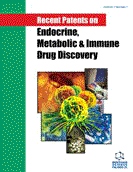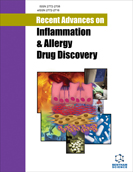Abstract
Glucose-dependent insulinotropic polypeptide (GIP) and glucagon-like peptide (GLP-1) are the 2 major incretin hormones released after meals to enhance glucose-stimulated insulin secretion. In patients with type 2 diabetes, a loss of activity of GIP for insulinotropic function and a reduced secretion of GLP-1 exist in response to oral glucose while GLP-1 action is preserved. GLP-1 is therefore an attractive avenue for treating type 2 diabetes. Due to the short circulating half-life of GLP-1, which is degraded by dipeptidyl peptidase IV (DPP-IV), 2 approaches have been undertaken. One is to develop long-acting GLP-1 analogs, such as exendin-4 that is resistant to degradation. Here we review another approach for developing DPP-IV inhibitors. This group of potential drugs covers several major chemical classes and their derivatives, such as amino acid amide, carbocyclic, alkylamine, and heterocyclic compounds. More than 100 patents have been issued for DPP-IV inhibitors to be used either as a monotherapy or in combination with other antidiabetic agents for the treatment of type 2 diabetes, as well as metabolic syndrome, osteoporosis, and arthritis. Structure-based drug design is currently under intensive investigation for future development of more selective therapeutic agents.
Keywords: Dipeptidyl peptidase IV, DPP-IV inhibitors, GLP-1, type 2 diabetes
Recent Patents on Endocrine, Metabolic & Immune Drug Discovery (Discontinued)
Title: Dipeptidyl Peptidase-IV Inhibitors: An Evolving Treatment for Type 2 Diabetes from the Incretin Concept
Volume: 1 Issue: 1
Author(s): Yau-Jan Chyan and Lee-Ming Chuang
Affiliation:
Keywords: Dipeptidyl peptidase IV, DPP-IV inhibitors, GLP-1, type 2 diabetes
Abstract: Glucose-dependent insulinotropic polypeptide (GIP) and glucagon-like peptide (GLP-1) are the 2 major incretin hormones released after meals to enhance glucose-stimulated insulin secretion. In patients with type 2 diabetes, a loss of activity of GIP for insulinotropic function and a reduced secretion of GLP-1 exist in response to oral glucose while GLP-1 action is preserved. GLP-1 is therefore an attractive avenue for treating type 2 diabetes. Due to the short circulating half-life of GLP-1, which is degraded by dipeptidyl peptidase IV (DPP-IV), 2 approaches have been undertaken. One is to develop long-acting GLP-1 analogs, such as exendin-4 that is resistant to degradation. Here we review another approach for developing DPP-IV inhibitors. This group of potential drugs covers several major chemical classes and their derivatives, such as amino acid amide, carbocyclic, alkylamine, and heterocyclic compounds. More than 100 patents have been issued for DPP-IV inhibitors to be used either as a monotherapy or in combination with other antidiabetic agents for the treatment of type 2 diabetes, as well as metabolic syndrome, osteoporosis, and arthritis. Structure-based drug design is currently under intensive investigation for future development of more selective therapeutic agents.
Export Options
About this article
Cite this article as:
Chyan Yau-Jan and Chuang Lee-Ming, Dipeptidyl Peptidase-IV Inhibitors: An Evolving Treatment for Type 2 Diabetes from the Incretin Concept, Recent Patents on Endocrine, Metabolic & Immune Drug Discovery (Discontinued) 2007; 1 (1) . https://dx.doi.org/10.2174/187221407779814570
| DOI https://dx.doi.org/10.2174/187221407779814570 |
Print ISSN 1872-2148 |
| Publisher Name Bentham Science Publisher |
Online ISSN 2212-3334 |
 13
13Related Articles
-
The Complex Actions of Statins in Brain and their Relevance for Alzheimer`s Disease Treatment: An Analytical Review
Current Alzheimer Research Targeting Insulin Signaling for the Treatment of Alzheimer's Disease
Current Topics in Medicinal Chemistry The MHC Genes in Psoriasis
Current Genomics Electrotransfer into Skeletal Muscle for Protein Expression
Current Gene Therapy Molecular Pathogenesis of Pancreatic Cancer: Advances and Challenges
Current Molecular Medicine Redox-Driven Events in the Human Immunodeficiency Virus Type 1 (HIV-1) Infection and their Clinical Implications
Current HIV Research Toward a Biochemical Diagnosis of NASH: Insights From Pathophysiology For Distinguishing Simple Steatosis From Steatohepatitis
Current Medicinal Chemistry Ion Transporters in Brain Tumors
Current Medicinal Chemistry Structure, Function, and Signaling of Taste G-Protein-Coupled Receptors
Current Pharmaceutical Biotechnology Large Scale Refolding and Purification of the Catalytic Domain of Human BACE-2 Produced in E. coli
Protein & Peptide Letters Updates of mTOR Inhibitors
Anti-Cancer Agents in Medicinal Chemistry Investigating the Cellular Targets of HIV Protease Inhibitors: Implications for Metabolic Disorders and Improvements in Drug Therapy
Current Drug Targets - Infectious Disorders C7-Substituted Estranes and Related Steroids
Mini-Reviews in Organic Chemistry Antihyperglycemic Potential of Matricaria pubescens (Desf.) Schultz. in Streptozotocin-induced Diabetic Rats
Cardiovascular & Hematological Disorders-Drug Targets Managing Comorbidity in COPD: A Difficult Task
Current Drug Targets 18F-FDG-PET Correlates of Impulse Control Disorder in a Diabetic Patient
Endocrine, Metabolic & Immune Disorders - Drug Targets Advanced Glycation and ROS: A Link between Diabetes and Heart Failure
Current Vascular Pharmacology Editorial : Meet Our Editorial Board Member
Current Nutrition & Food Science Editorial (Mini Hot-Topic: Determination of the Antioxidant Capacity of Dietary Substances and Extracts from Natural Sources at Molecular, Cellular And Whole Tissue Level: Sensors and Complex Microfluidic Structures)
Current Analytical Chemistry The Critical Role of Toll-Like Receptor Signaling Pathways in the Induction and Progression of Autoimmune Diseases
Current Molecular Medicine






















